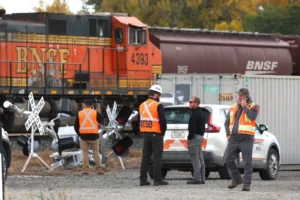The Future of Farming: Vertical Harvest Reimagines Growing Produce in a Sustainable Urban Oasis
Jackson startup’s efficient indoor agriculture model provides year-round fresh veggies in food deserts
- Published In: Other News & Features
- Last Updated: Apr 16, 2023
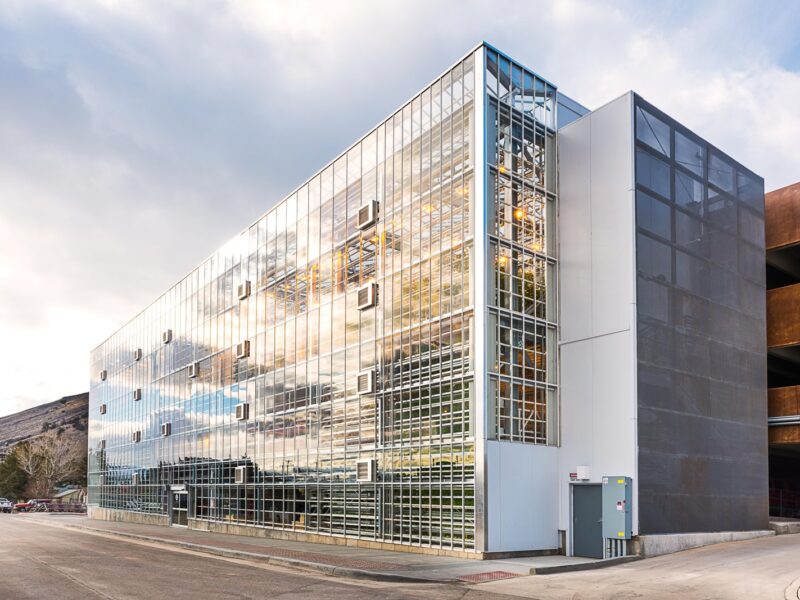
Vertical Harvest, located in downtown Jackson, provides fresh produce year-round. (Courtesy photo from Vertical Harvest)
By Samuel Gilbert
Special to the Wyoming Truth
This story has been corrected to reflect the updated square footage of a second farm under construction as of 4 p.m. MT on April 17.
JACKSON, Wyo.—On average, fresh produce travels over 1,500 miles from farm to fork in the United States—the equivalent of driving from Los Angeles to Houston. In most cities only 2% of food consumed by residents is grown locally, with tens of millions of people lacking access to fresh, healthy, affordable produce.
Enter Vertical Harvest, North America’s first vertical hydroponic greenhouse that is addressing the issue of food deserts. The Jackson-based company, which opened in 2016 and grows fresh vegetables, is pioneering sustainable and equitable urban farming to build food security, provide jobs and improve economic security in America’s cities.
“It’s connecting farms to the urban center,” said Nona Yehia, co-founder and CEO.
An indoor oasis
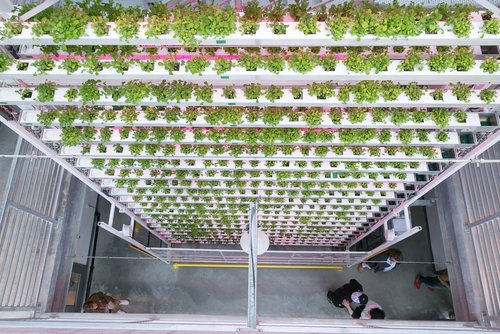
On a blustery day, Yehia stood in the atrium on the ground floor of Vertical Harvest, a three-story metal and glass building that was balmy and humid, with each ascending floor warmer than the one below. “In order to bolster the local food economy [in Jackson] at scale, you have to be able to grow year-round,” she said at the start of a tour for the Wyoming Truth and several other visitors.
In the break room, a carousel of plants rotated slowly, their bright green leaves contrasting with downtown Jackson’s snowy white backdrop.
“If we could do it here, could we go to places like New York? Could we feed populations and reconnect the farm to downtown?” Yehia asked.
Vertical Harvest is prepared to do just that, as it embarks on an ambitious expansion plan. The for-profit, female-founded company intends to open farms in 15 cities in the next five years, co-locating farms with affordable housing in underserved communities nationwide. The company’s inclusive employment model also provides careers for people with developmental disabilities.
“We are really positioning ourselves to solve more than one problem,” said Yehia. “Food is the defining issue of the 21st century. This is a social justice issue, a public health issue and an economic resiliency issue.”
Building food infrastructure
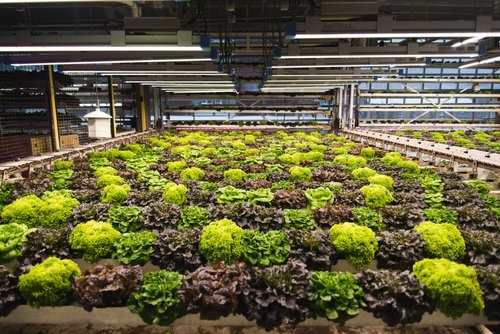
Vertical farming — the practice of producing crops atop one another in an enclosed controlled environment — is one of the fastest-growing industries in agriculture, projected to be worth nearly $25 billion by the end of the decade.
Farms like these can be located anywhere in the world, unconstrained by soil quality, climate or space. Proponents say vertical farming is more sustainable than conventional agriculture, using less water, fewer inputs and exponentially less land.
Ecologist/microbiologist Dickson Despommier, who has been called the godfather of modern vertical farming, said growing crops inside multi-story buildings will be critical as climate change and other factors “clamp down on our ability to grow food outdoors.”
“Currently, we’re facing a food crisis that will need to be addressed in ways that traditional farming can’t,” Despommier told the Wyoming Truth.
By 2050, he estimates that a land area equivalent to that of Brazil will be needed to continue conventional farming to feed the global population. “I predict in 20 years, urban farmers will supply their population with 80% of their food,” he said.
The modern concept of vertical farming was popularized by Despommier in the late 1990s. An emeritus professor at Columbia University, he envisioned skyscraper greenhouses that could sustainably feed residents of crowded cities and address food insecurity caused by the modern agricultural system.
“We don’t have that many options,” said Despommier. “To stay the way we are now, we have to raise food differently.”
Yehia first met Despommier in 2009 during the early planning stages of Vertical Harvest. She was inspired by the urgency of Despommier’s ideas, outlined in his book “The Vertical Farm: Feeding the World in the 21st century.”
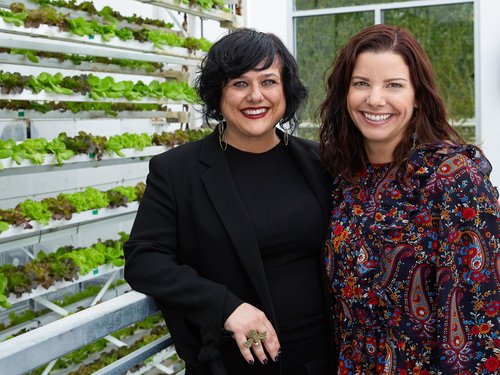
“What [Despommier] really instilled in me was the need for and potential of this prototype,” said Yehia, an architect by trade. “He positioned it as an urban necessity, a piece of infrastructure that responds to the need for food security.”
The vertical farm in Jackson, Yehia explained, was born out of constraints associated with mountain town’s geography. Farmland is hard to come by, and Jackson is surrounded by national parks and exorbitant local property prices that prohibit conventional farming.
At 6,200 feet, Jackson experiences long, cold winters, a short growing season and temperature swings of 40 degrees even in the summer. As a result, most of the produce is shipped into town, often from thousands of miles away.
Vertical Harvest grows vegetables in Jackson year-round, providing fresh produce to local grocery stores, restaurants and direct to consumers.
The three-story building is a series of stacked greenhouses with different microclimates, growing chard, kale, tomatoes and “mighty microgreens.” The 1,350-square-foot space, 50 by 30-feet wide, produces roughly 100,000 pounds on the equivalent of just one-tenth of an acre.
The hydroponic growing system uses 90% less water and 95% less fuel.
“All of the water, with the exception of the tomato room, recirculates, and it is used again,” said Emily Churchill, Vertical Harvest’s director of growing and food safety, standing near rows of tomatoes stretching toward the ceiling. The flowering plants are pollinated by a hive of bumblebees.
Instead of pesticides, Vertical Harvest uses an integrated pest management system where beneficial insects control unwanted ones.
“Like ‘Star Wars’ with bugs,” said Yehia, describing a scene of parasitic wasps patrolling the farm, picking off white flies.
Microgreens, Vertical Harvest’s highest-value product, are grown under rows of LED lights that cast an eerie purple glow on small pea, radish and kale shoots.
“The microgreens are not only the Willy Wonka part of the tour,” said Yehia of the flavor profiles of the small greens, “they also help us address nutrition gaps in communities.”
Future-focused farming

Yehia hopes Vertical Harvest can help elevate the farm in cities, where nearly 90% of the American and 68% of the global population will reside by 2050.
Vertical Harvest’s second location is currently under construction in Westbrook, Maine and is set to open by early 2024. The 54 thousand-square-foot building will have 15 times the growing area of the Jackson farm and is expected to produce two million pounds of produce that will be sold to schools, hospitals, restaurants, markets and consumers.
Said Yehia: “If you can imagine an Amazon facility for food, that is what we are creating in Maine.”
Still, questions remain about how vertical farms can compete with traditional farming. A recent report in Fast Company outlined a faltering industry with many companies “floating” on Silicon Valley venture capital and growing concerns about costs of tech-heavy farming.
For Yehia, whose raised over $8 million in 2022 to fund expansion, technology is less critical than operations and people. “We are farmers first; we are not technologists,” she said.
The lessons learned in Jackson will be applied to other locales. Vertical Harvest’s goal is to open 15 urban farms in the next five years, co-locating them with affordable housing and other critical infrastructure. The company also has announced plans to build an operation in Detroit and is exploring sites in other cities.
Through its “Grow Well” workforce model, Vertical Harvest provides jobs for underemployed and forgotten workers. Roughly half of the Jackson staff have developmental disabilities; the Maine farm will employ 50 underserved community members.
“We are focusing on abilities: How can we tailor the job to that kind of ability and ability to the job?” said Yehia.
Case in point: Johnny Fifles. A racks senior associate, he joined Vertical Harvest as an entry-level farmer seven years ago. Today, Fifles, who has autism, runs the microgreen department, utilizing his unique spatial abilities and visual acuity.
Fifles is fastidious, perfectly seeding a tray “99% of the time,” said Yehia. His understanding of how the department operates makes him essential to maintaining quality assurance and integrating new technology.
As the tour came to an end, Yehia reflected on the founding principle of food equity that continues to guide the company.
“The right to quality food is a fundamental human right,” she said. “The farm is really the first step in really shining the light on the importance of the local food system.”






